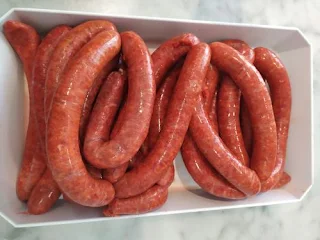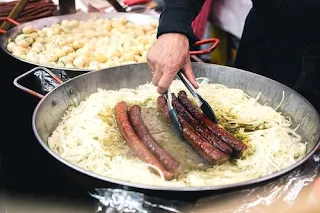From Marrakech to New Orleans: Merguez and Andouille Sausages
Comparing Sausages from Two Different Continents: Moroccan Merguez Sausage and Louisiana Andouille Sausage.
Merguez is a spicy North African sausage traditionally made from ground lamb or beef and flavored with spices such as paprika, cumin, garlic, and chili. It is often grilled or pan-fried and served with bread or Merguez is commonly used in dishes like tagines, couscous, and stews.
In the United States, Andouille is a smoked sausage that has its roots in French cuisine but is commonly associated with Cajun and Creole cooking in Louisiana. While traditional French andouille is not necessarily red, the American version often features a reddish hue due to the use of paprika and other seasonings. It is typically made from smoked pork, heavily spiced with ingredients such as garlic, pepper, and herbs.
When comparing sausages from two different continents, we can focus on the distinctive characteristics of Moroccan Merguez sausage and Louisiana Andouille sausage. These two sausages represent the culinary traditions of North Africa and the United States. Merguez brings bold spiciness with North African influences, while Andouille showcases smokiness and a unique blend of Cajun and Creole flavors. Exploring these sausages allows for an appreciation of the diverse and delicious world of global cuisine.
Merguez is a type of sausage with a rich history and wide usage across North Africa.
Merguez sausage originated in North Africa, particularly in Algeria and Morocco. It has been a part of North African cuisine for centuries. Merguez is deeply ingrained in the culinary traditions and cultural celebrations of North Africa. It is commonly served during festive occasions, family gatherings, and religious festivals such as Eid al-Adha.
The name merguez is derived from the Arabic word mirkas, which means small sausage. The sausage was introduced to France through the colonial ties with Algeria and eventually gained popularity in Mediterranean and Middle Eastern cuisines.
Traditionally, Merguez sausages have a vibrant red color. This is often achieved by incorporating ingredients like paprika or dried red chili peppers into the seasoning mix. Merguez is known for its bold and spicy flavor profile. It typically contains a combination of spices such as paprika, cumin, coriander, and chili pepper, which give it a distinctive and aromatic taste.
While lamb is the most common meat used in Merguez, it can also be made with a combination of lamb and beef or solely beef. The choice of meat can vary based on regional preferences and availability. They are often grilled or pan-fried to enhance their taste and texture. Merguez can be enjoyed on its own, served as a main course, or used as an ingredient in various dishes. It is commonly found in dishes like couscous, tagines, sandwiches, stews, and salads. Merguez adds a bold and flavorful element to these dishes.
Merguez Sausage Recipe Ingredients and Directions.
Ingredients
1 pound ground lamb
1/2 pound ground beef
2 cloves of garlic, minced
2 teaspoons paprika
1 teaspoon ground cumin
1 teaspoon ground coriander
1 teaspoon ground fennel seeds
1/2 teaspoon cayenne pepper (adjust to taste)
1 teaspoon salt
1/2 teaspoon black pepper
2 tablespoons chopped fresh parsley
Natural casings
Directions
In a large mixing bowl, combine the ground lamb and beef. Add minced garlic, paprika, cumin, coriander, fennel seeds, cayenne pepper, salt, black pepper, and parsley. Mix all the ingredients thoroughly until well combined. If using natural casings, rinse them under cold water and soak them in water for about 30 minutes to soften.
Stuff the mixture into casings, ensuring they are evenly filled. Alternatively, you can shape the mixture into sausage patties if you prefer. If using casings, tie off the sausages into individual links using kitchen twine. Prick any air bubbles using a pin.
Heat a grill or a skillet over medium heat. Cook the sausages for about 10-12 minutes, turning occasionally, until they are browned and cooked through. Once cooked, remove the sausages from heat and let them rest for a few minutes before serving.
Andouille sausage brings a smoky and robust flavor to dishes, making it a beloved ingredient in Cajun and Creole cuisines, especially in Louisiana.
Andouille sausage has its origins in France, particularly in the region of Brittany. The name Andouille comes from the Latin word inductilia, meaning things to be introduced. It was traditionally made by using leftover parts of the pig, such as the head, tripe, and other offal, which were heavily smoked to preserve them. Over time, the recipe and ingredients evolved, and Andouille sausage became associated with Cajun and Creole cuisines in Louisiana, USA.
Andouille sausage is a key ingredient in Cajun and Creole cooking. It is highly favored for its smoky and robust flavor, which adds depth to dishes. It is commonly used in jambalaya, gumbo, étouffée, red beans and rice, and other Louisiana-style dishes. Andouille sausage can also be enjoyed on its own, grilled or smoked, and served as a part of a charcuterie board or as a flavorful addition to sandwiches.
One of the defining characteristics of Andouille sausage is its smoky flavor. Traditionally, the sausage was heavily smoked over pecan wood or other hardwoods, which contributes to its distinct taste. Andouille sausage has a coarse texture due to the coarse grinding of the meat. This texture helps it retain its shape and adds to its unique eating experience.
Andouille sausage holds cultural significance in Louisiana and is deeply ingrained in the region's culinary heritage. It is a symbol of the state's rich food culture and is celebrated in festivals and events such as the annual Andouille Festival in LaPlace, Louisiana.
Recipe for Andouille Sausage.
Ingredients
2 pounds pork shoulder, cut into small pieces
1/2 pound pork fatback, cut into small pieces
3 cloves garlic, minced
2 tablespoons paprika
1 tablespoon salt
1 tablespoon black pepper
2 teaspoons dried thyme
2 teaspoons dried oregano
1 teaspoon cayenne pepper
1 teaspoon smoked paprika
1/2 teaspoon ground allspice
Natural casings
Directions
In a large mixing bowl, combine the pork shoulder, pork fatback, minced garlic, paprika, salt, black pepper, dried thyme, dried oregano, cayenne pepper, smoked paprika, and ground allspice. Mix well to evenly distribute the seasonings.
If using natural casings, rinse them under cold water and soak them in water for about 30 minutes to soften. Pass the meat mixture through a meat grinder fitted with a coarse grinding plate.
Stuff the mixture into casings, ensuring they are evenly filled. Alternatively, you can shape the mixture into sausage patties if you prefer. If using casings, tie off the sausages into individual links using kitchen twine. Prick any air bubbles using a pin.
Place the sausages on a wire rack and let them dry in the refrigerator for a few hours or overnight to develop the flavors. Once dried, the sausages can be cooked by grilling, smoking, or pan-frying until they are browned and cooked through. Once cooked, remove the sausages from heat and let them rest for a few minutes before serving.
Merguez and Andouille sausages are known for their bold flavors and red color.
Merguez sausage is commonly used in North African dishes like tagines, couscous, and stews, while Andouille sausage is a staple in Louisiana dishes like gumbo, jambalaya, and red beans and rice.
Whether it's the spiciness of Merguez or the smokiness of Andouille, both sausages bring robust and distinct tastes to dishes. Merguez represents the flavors of North Africa, while Andouille showcases the culinary traditions of Louisiana. Exploring these sausages allows for a delicious exploration of global cuisine.
Both sausages hold cultural significance. Merguez sausage is deeply rooted in North African culinary traditions and is often enjoyed during festive occasions and celebrations. Andouille sausage is closely associated with the Cajun and Creole cuisines of Louisiana and is celebrated in festivals and events.
While they have traditional uses, both sausages are versatile and can be enjoyed in various ways. They can be grilled, pan-fried, smoked, or used as an ingredient in a wide range of dishes, adding flavor and depth to the overall preparation.
If you're interested in making Merguez and Andouille Sausages at home, here are ten tips.
Invest in a good quality meat grinder and sausage stuffer. These tools will make the process much easier and give you better control over the texture and consistency of the sausages.
Choose high-quality meat for your sausages. It's important to have a good balance of lean meat and fat to achieve the desired texture and flavor. For example, a pork shoulder or beef chuck are popular choices. You can also mix different meats together for unique flavor combinations.
Before grinding the meat, ensure it is well-chilled but not frozen. Cold meat is easier to handle and helps maintain the texture. You can cut the meat into small pieces and partially freeze it for about 30 minutes before grinding.
Once the meat is ground, mix it thoroughly with the seasoning and spices. Ensure the ingredients are evenly distributed throughout the mixture. Mixing by hand or using a stand mixer with a paddle attachment are common methods.
Experiment with different seasonings and spices to achieve the flavor profile you desire. Start with a basic recipe and adjust the seasonings to your taste. Remember to consider the salt content, as it helps with preservation and flavor.
If using casings, make sure they are properly soaked and rinsed before use. Leave some slack in the casing to prevent bursting. Use a sausage stuffer to fill the casings evenly, avoiding air bubbles. Twist or tie off the sausages into desired lengths.
Sausages can be cooked in various ways, including grilling, pan-frying, baking, or smoking. The cooking method will depend on the type of sausage and your preference. Ensure the sausages are cooked to a safe internal temperature to prevent foodborne illnesses.
If you have leftover sausages, store them in airtight containers or freezer bags in the refrigerator or freezer. Properly stored sausages can be enjoyed for several days in the refrigerator or for months in the freezer.
Don't be afraid to experiment with different flavors, ingredients, and sausage styles. It's a creative process, and you can develop your unique recipes and combinations over time.
Follow proper food safety practices throughout the sausage-making process. Keep your workspace clean, handle the meat with clean hands and utensils, and ensure proper cooking temperatures to avoid any food-borne illnesses.










